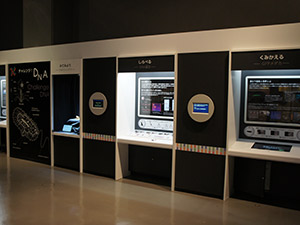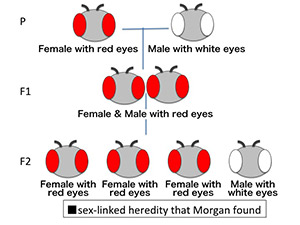Nagoya City Science Museum
TOP > Exhibition Guide > Keyword Search > Starting with "D" > DNA > Challenge! DNA
Challenge! DNA



Purpose of Exhibition
There are three booths—"Discover mutants", "DNA profiling", "Modify to GFP medaka" and a showcase for topics of DNA.
Since genes were identified as DNA (deoxyribonucleic acid), which is a substance with a relatively simple structure, DNA technologies have been utilized in many fields such as medicine, criminal investigations, and agriculture. This exhibit is intended for visitors to develop an interest in mechanism of DNA and its applications through simulating DNA investigations. Challenge three missions yourself recalling the molecular structure of DNA.
Additional Knowledge
Booth 1: "Discover mutants"
One approach to genetic research is to find something that differs from others in characteristics (i.e. mutations) and then to study how it's inherited, where they are located on chromosomes, and the base sequences of DNA.
In this exhibit, visitors can observe the mutation of Drosophila, which is a small fly studied genetically well.
White-eyed mutants discovered in 1910 by Thomas Hunt Morgan (USA) led to research into the locations of genes on chromosomes.
Booth 2: "DNA profiling"
DNA profiling is used in criminal investigations and to determine parentage and breed.
These tests compare the part of DNA with polymorphism(individual differences in the base sequence). One common approach of DNA tests is the DNA fingerprint method.
First, you collect the individual DNA that you want to compare and then fragment it with restriction enzyme.
You process the fragments in gel electrophoresis, which will disclose band patterns like barcodes. This allows you to identify an individual or determine parentage by comparing the pattern. In this exhibit, let's find out a parent of a mongrel dog using the DNA profiling. The band patterns for a mixed-breed puppy (barcode pattern) reflect the genetic DNA inherited from its parents. Therefore, each barcode should match one parent's patterns.
Booth 3: "Modify to GFP medaka"
The Genetic Engineering Lab on this exhibition floor displays live medaka glowing in green due to GFP (green fluorescent protein). GFP is a protein discovered in Aequorea victoria, a type of jellyfish, by Dr. Osamu Shimomura in 1962, and is not made naturally by medaka.
However, all organisms use the same mechanisms of DNA for their genes, which is why we are able to modify it. To create GFP medaka, micro-injectiontechniqueis used to directly inject the target genes with a needle into the fertilizedegg of the madaka. In this exhibit like a game, experience the simulated micro-injection as if you are a researcher.
Article by Chieko Osaka, curator
